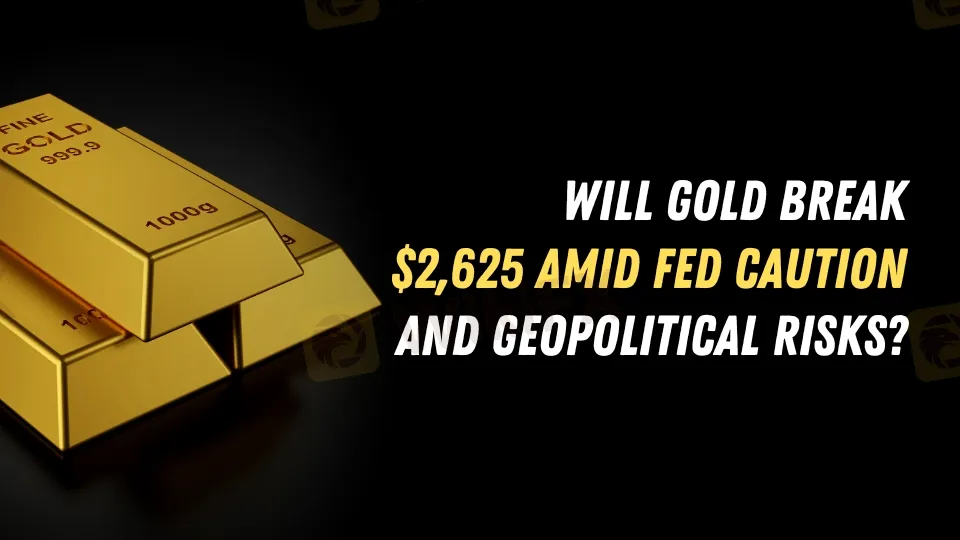简体中文
繁體中文
English
Pусский
日本語
ภาษาไทย
Tiếng Việt
Bahasa Indonesia
Español
हिन्दी
Filippiiniläinen
Français
Deutsch
Português
Türkçe
한국어
العربية
Will Gold Break $2,625 Amid Fed Caution and Geopolitical Risks?
Abstract:Gold price (XAU/USD) hovers near $2,625, supported by central bank demand, geopolitical tensions, and uncertainty over Trump's policies, but Fed caution limits the upside.

During the early Asian session on Thursday, the gold price (XAU/USD) was up slightly by roughly $2,625. Uncertainty around Donald Trump's trade policy, geopolitical conflicts, and increased central bank gold demand all bolster the yellow metal. However, the US Federal Reserve's (Fed) cautious posture may restrict gold's potential rise.
Traders are looking for new factors that could impact the Fed's interest rate forecast this year. Fed Chair Jerome Powell signaled in December that he would be cautious about further rate cuts after a 25 basis point reduction. This stance may give the Greenback some strength, undermining the USD-denominated gold price.

On Thursday, the US weekly Initial Jobless Claims report may provide more information about the strength of the US labor market. Meanwhile, on Friday, the US S&P Global Manufacturing PMI for December will be closely watched for further signals of economic growth or downturn.
On the other hand, policy uncertainty surrounding incoming President Donald Trump may increase the attraction of the precious metal as a haven. Geopolitical concerns, notably in the Middle East and the continuing Russia-Ukraine war, are expected to linger throughout the year, reinforcing gold's safe haven position and increasing demand.
A rise in global central bank gold purchases is projected to support the precious metal's upward trend. According to the World Gold Council study, major central banks are projected to buy more gold during the next year, boosting demand for the yellow metal.
Summary
Gold prices (XAU/USD) remain constant at $2,625, boosted by rising central bank demand, geopolitical uncertainty, and Donald Trump's unpredictable policy. However, the US Federal Reserve's cautious approach to interest rate decreases may limit the yellow metal's potential for large gains. Geopolitical uncertainties, particularly in the Middle East and Ukraine, as well as a potential increase in global central bank gold purchases, are projected to keep gold's safe-haven appeal. Key US economic data, such as Initial Jobless Claims and the S&P Global Manufacturing PMI, are likely to have an impact on the gold market in the coming days.

Disclaimer:
The views in this article only represent the author's personal views, and do not constitute investment advice on this platform. This platform does not guarantee the accuracy, completeness and timeliness of the information in the article, and will not be liable for any loss caused by the use of or reliance on the information in the article.
Read more

YouTube Creators Sue PayPal Over Honey’s Affiliate Tool
YouTube creators sue PayPal over the Honey browser tool, alleging redirected affiliate commissions. The case highlights affiliate fraud and its impacts on the creator economy.

OPEC's Profound Influence on the Oil Market
At present, oil prices remain relatively stable, but global economic recovery and shifting market demands continue to drive price fluctuations. Amid an uncertain global economic and geopolitical landscape, OPEC’s policies and actions remain key determinants of oil prices.

What Euro Investors Can't Afford to Miss
For euro investors, geopolitical factors, inflation data, and the European Central Bank's policy direction will determine the market trends over the next few months.

How Big is the Impact of the USD-JPY Rate Gap on the Yen?
The U.S. Federal Reserve's repeated rate cuts and the narrowing of the U.S.-Japan interest rate differential are now in sight. So, why is the U.S.-Japan interest rate differential so important for the yen’s safe-haven appeal, especially when global economic uncertainty rises?
WikiFX Broker
Latest News
Will Gold Break $2,625 Amid Fed Caution and Geopolitical Risks?
ECB Targets 2% Inflation as Medium-Term Goal
New Year, New Surge: Will Oil Prices Keep Rising?
PH SEC Issues Crypto Guidelines for Crypto-Asset Service Providers
FTX Chapter 11 Restructuring Plan Activated: $16 Billion to Be Distributed
Think Before You Click: Malaysian Loses RM240,000 to Investment Scam
Bithumb CEO Jailed and Fined Over Bribery Scheme in Token Listing Process
WikiFX Review: Something You Need to Know About Saxo
Is PGM Broker Reliable? Full Review
Terraform Labs Co-founder Do Kwon Extradited to the U.S. to Face Fraud Charges
Currency Calculator






